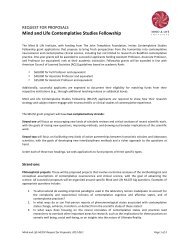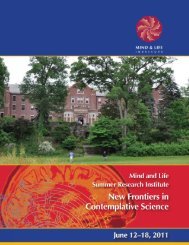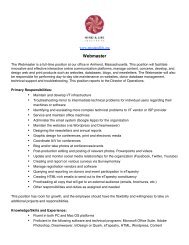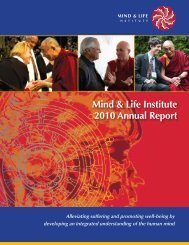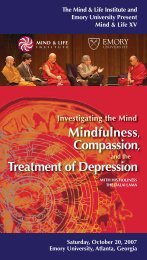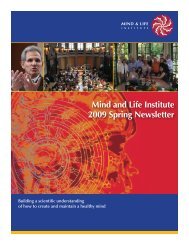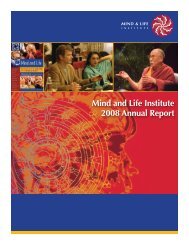to view the brochure from the conference (PDF). - Mind & Life Institute
to view the brochure from the conference (PDF). - Mind & Life Institute
to view the brochure from the conference (PDF). - Mind & Life Institute
You also want an ePaper? Increase the reach of your titles
YUMPU automatically turns print PDFs into web optimized ePapers that Google loves.
PRESENTATION THE DIALOGUE ABSTRACTS<br />
complex and fast moving mental events and processes in which numerous discrete<br />
“mental qualities” (cetasika) – encompassing both <strong>the</strong> basic functions and emotions<br />
of <strong>the</strong> mind – interact at various stages <strong>to</strong> create our experience of <strong>the</strong> world. Within<br />
this syn<strong>the</strong>tic process particular mental qualities are highlighted as performing very<br />
specific functions such as attention, categorizing, and also mindfulness, but always in<br />
simultaneous association with o<strong>the</strong>r mental qualities. The way <strong>the</strong> mind handles and<br />
pays attention <strong>to</strong> <strong>the</strong> various objects of consciousness at <strong>the</strong> basic level of awareness<br />
is considered crucial in this endeavour. This means that much of Buddhist contemplative<br />
practice involves a kind of meta-awareness: self-moni<strong>to</strong>ring <strong>the</strong> processes by<br />
which <strong>the</strong> mind is aware of and pays attention <strong>to</strong> objects of consciousness. Questions<br />
<strong>to</strong> be discussed include: how do such Buddhist accounts of <strong>the</strong>se faculties relate <strong>to</strong><br />
contemporary definitions of “mindfulness” in scientific studies How can we<br />
understand <strong>the</strong> relation between attention and memory in <strong>the</strong> practice of<br />
mindfulness<br />
Day Three<br />
Wednesday, April 8 – Part I:<br />
Mental Processes for Attention and Cognitive Control<br />
in Children and Adolescents<br />
Dialogue leader: Adele Diamond<br />
Attentional control, self-regulation, and inhibi<strong>to</strong>ry control are not immutable. They<br />
can be improved even in children as young as 4–5 years, in regular classrooms, with<br />
regular teachers, without special equipment. First we will explore why inhibi<strong>to</strong>ry<br />
control is so critically important, especially during development. A child may know<br />
what he or she should do, and want <strong>to</strong> do, but still not be able <strong>to</strong> act accordingly<br />
because of insufficient inhibi<strong>to</strong>ry control. Adults may not appreciate how inordinately<br />
difficult inhibition is for young children because it is so much less taxing for<br />
us. The educational practices that improve attentional control and self-regulation not<br />
only lead <strong>to</strong> better academic outcomes, but <strong>the</strong>y will also reduce <strong>the</strong> incidence and<br />
severity of mental health disorders where poor self-regulation is at <strong>the</strong> core (such as<br />
ADHD and addiction). Many issues are not simply education issues or health issues;<br />
<strong>the</strong>y are both. Activities that often get squeezed out of school curricula, including <strong>the</strong><br />
arts and physical exercise, are excellent for developing attentional control, selfregulation,<br />
and inhibi<strong>to</strong>ry control, and thus can be critical for success in school and in<br />
life. Improvement of critical skills need not be painful; indeed <strong>the</strong> evidence shows<br />
that children who spend more time in supervised play at school perform better on<br />
objective academic outcome measures than those who spend more time receiving<br />
direct academic instruction. Questions <strong>to</strong> be discussed are: what are traditional<br />
Tibetan Buddhist insights about training attentional control in young people What<br />
are <strong>the</strong> main modalities for doing this Is <strong>the</strong>re any sense of a “developmentally<br />
appropriate” set of contemplative activities for children and adolescents in <strong>the</strong><br />
traditions<br />
7



